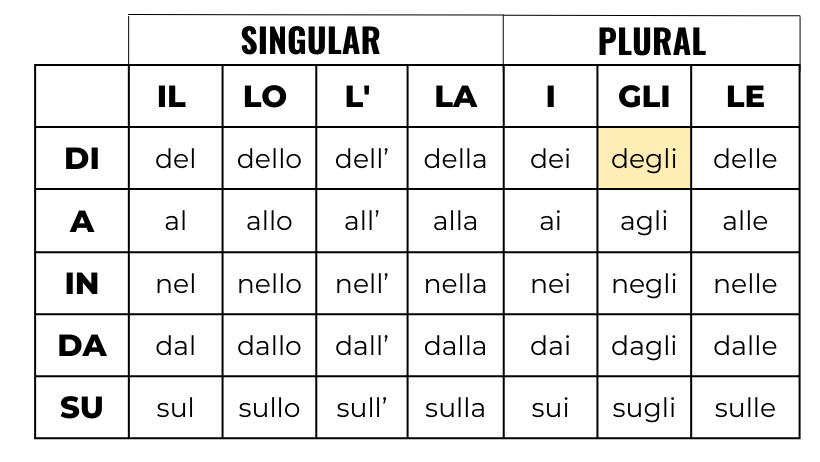Prepositions are the small words that go before Noun Phrases that tell us the position or direction of something in relation to another thing. They include words like ‘of’, ‘in’, ‘at’, and ‘to’ and they are essential to forming grammatical sentences in any language.
Italian prepositions can be confusing when you are first learning them because there is rarely always a one-to-one equivalent in terms of the meaning of each preposition for English speakers. What you’ll find is that a single Italian preposition can have multiple different meanings in English depending on the context. Likewise, a certain preposition in English, like ‘at’ for example, can be said using three different Italian prepositions, so it’s really important to know the scenario that each preposition is used in.

Here are the most important prepositions you need to know to start you off with Italian:
DI ???? from / of / about
DI means ‘from’ when you are talking about the place that someone is from such as a town, city, region or state. It’s like saying that you are “of” that place because that is where you belong, it’s where you originate from. DI is not used, however, when saying what country you are from.
Sono di Roma
I’m from Rome
DI means ‘of’ when you are talking about possession. There is no Italian equivalent of the English ‘s, so to speak about “someone’s something”, it is always structured in Italian like “the something of someone”. DI can also mean ‘of’ in the exact same way as it’s used in English when talking about what something is made up of.
Il cane di Marco è carinissimo!
Marco’s dog is so cute! (The dog of Marco)
Prendo un bicchiere di vino, grazie
I’ll have a glass of wine, thanks
DI means ‘about’ when expressing what someone is talking about.
Parli sempre di lui
You always talk about him
A ???? to / at / in
A means ‘to’ when talking about going to any general destination.
Vado a scuola
I’m going to school
A means ‘at’ when describing the general location of someone or something.
Siamo a casa
We’re at home
A means ‘in’ when talking about something that takes place or is located in a city or a town.
Lei vive a Napoli
She lives in Napoli
IN ???? in / at / to
IN is used anytime that you are saying that something or someone is located within or going to an enclosed space.
Marta è in macchina
Marta is in the car
Gianni e Alessia sono in palestra
Gianni and Alessia are at the gym
Vado in chiesa
I’m going to church

DA ???? from / at / to
DA means ‘from’ when expressing movement away from somewhere.
Lei arriva da Milano domani
She arrives from Milan tomorrow
DA means ‘at’ when saying that someone or something is located at a person’s home or place of business.
Sono da Vincenzo
I’m at Vincenzo’s
DA means ‘to’ when saying that someone is going to a person’s home or place of business.
Vanno da te
They’re going to yours
SU ???? on / about
SU means ‘on’ when describing the location of something being physically on top of something else.
Trovi i giornali su quel banco di là
You’ll find the newspapers on that bench over there
SU means ‘about’ when expressing the topic of something.
Il discorso è su qualcosa di molto importante
The discussion is about something very important
CON ???? with
CON is an easy one! It’s used exactly the same way as in English.
Rimango con Cosima
I’m staying with Cosima
Andiamo con loro!
Let’s go with them!

Articulated Prepositions
When some of the Italian prepositions come before a definite article in Italian, the two words combine to become one and this is what’s referred to as an articulated preposition. The single articulated preposition is the equivalent of a Preposition + ‘the’ in English. The pattern is consistent for each of the articulated prepositions, but some of them take quite a different form compared to when they are used on their own.
In the table below are the articulated prepositions for the prepositions listed above. The preposition CON (‘with’) does not take an articulated form and is used with the standard form for each article. In spoken Italian, however, CON + IL sometimes gets contracted to form COL, but this is optional.

Examples
◉ DI + GLI = DEGLI → about the [MASCULINE PLURAL]
Parliamo degli bambini più tardi
Let’s talk about the kids later
◉ IN + LO = NELLO → in the [MASCULINE SINGULAR]
Il libro è nello zaino
The book is in the backpack
◉ DA + IL = DAL → from the [MASCULINE SINGULAR]
Ho una lettera dal dottore
I have a letter from the doctor
◉ A + LE = ALLE → to the [FEMININE PLURAL]
Devi dire qualcosa alle madri
You have to say something to the mothers
◉ SU + LA = SULLA → on the [FEMININE SINGULAR]
Siediti sulla sedia!
Sit on the chair!

